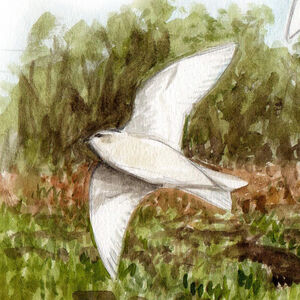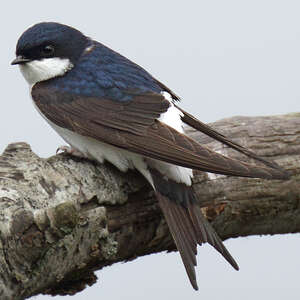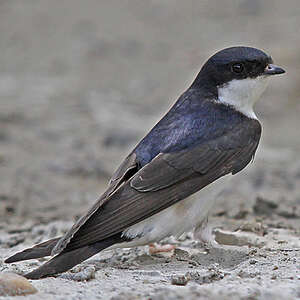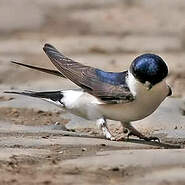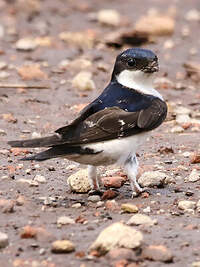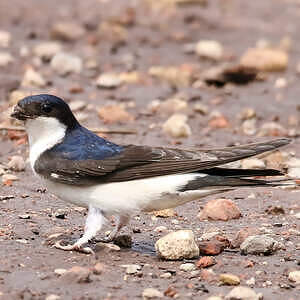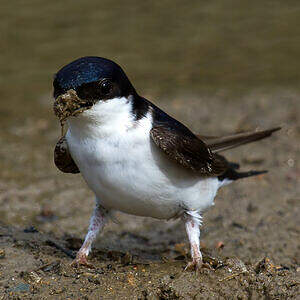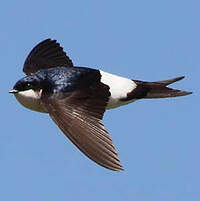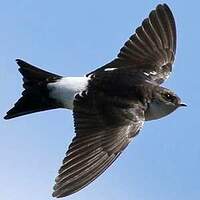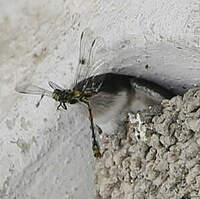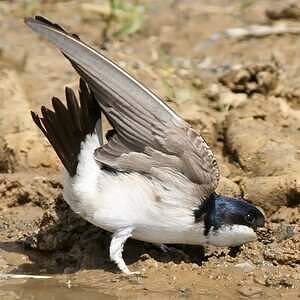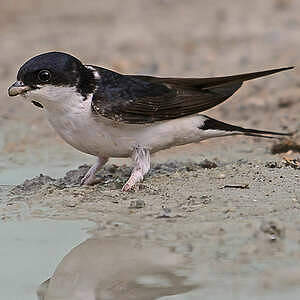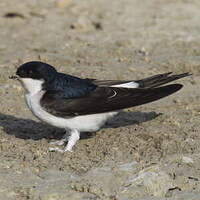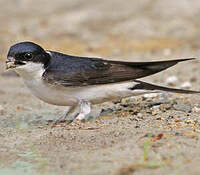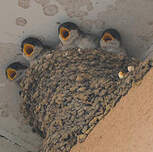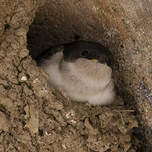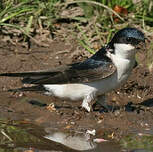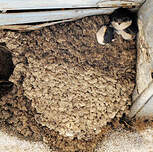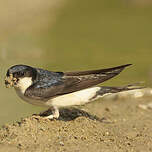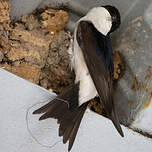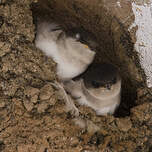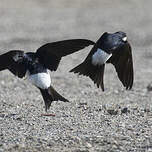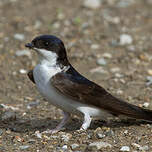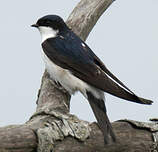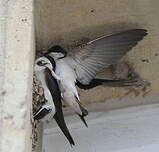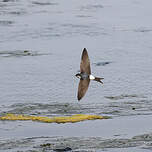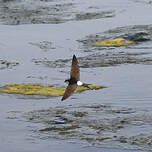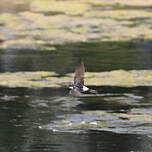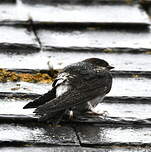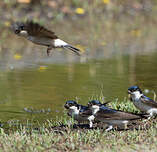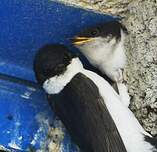Common House Martin
Delichon urbicum - Hirondelle de fenêtre
Description identification
The Common House Martin is a small swallow belonging to the Delichon genus, which is notably different from the Hirundo genus that the Barn Swallow belongs to. As these two species commonly co-habit in most of their ranges, we can compare them in some cases. The Common House Martin is smaller and bi-colored. Seen from above, it appears black with a white rump that is easily visible. In bright light, the adult shows blue reflections, similar to the Barn Swallow. Its wings and tail are a blackish brown without any reflections. Its entire underside is white, including the underwing coverts, with the black/white boundary just below the dark eye. The tail is clearly forked but with no streamers. The very small legs are feathered in white. The juvenile is dimmer and browner with much less blue reflections. It may be confused with the Sand Martin from afar if the white rump is not seen. There is a decrease in size of the birds as one moves from north to south. Three subspecies are currently described, with the 'urbicum' ssptype covering the largest part of Europe. They differ only in some small details of plumage and mensuration. Thus, the birds of the eastern 'lagopodum' subspecies have a slightly broader white rump.
Subspecific information 2 subspecies
- Delichon urbicum urbicum (w, c and n Europe to w Siberia)
- Delichon urbicum meridionale (n Africa and s Europe to sc Asia)
Foreign names
- Hirondelle de fenêtre,
- Avión común occidental,
- andorinha-dos-beirais,
- Mehlschwalbe,
- molnárfecske,
- Huiszwaluw,
- Balestruccio,
- hussvala,
- Taksvale,
- belorítka obyčajná,
- jiřička obecná,
- Bysvale,
- räystäspääsky,
- Huisswael,
- oreneta cuablanca comuna,
- Bæjasvala,
- oknówka (zwyczajna),
- mājas čurkste,
- mestna lastovka,
- Воронок,
- ニシイワツバメ,
- 西方毛脚燕,
- นกนางแอ่นมาตินพันธุ์ไซบีเรีย,
- 白腹毛腳燕〔西方毛腳燕〕,
Voice song and cries
The usual call is a low-pitched, rolled prrri that is very distinctive. The bird isn't stingy with it. The alarm call is a drawn-out tsiu that is often repeated. The song, emitted near the nest, is a prolonged babble that is reminiscent of that of the Common House Martin but less loud and without the rough syllables.
Habitat
The Common House Martin is a cliff-dwelling species, historically nesting beneath overhanging rocks from cliffs.
Behaviour character trait
The Common House Martin is a gregarious and social species, nesting often in populous colonies. The social character can be judged by the proximity of the nests which are often contiguous in a colony and can even overlap, and also by the gathering of individuals in the nests for the night. It has been noted that more than ten adult-sized swifts, the number of 13 has been cited, can gather at night in one single nest. On the flipside, in autumn 1974, prolonged bad weather caused the death of thousands of swifts crowded in the nests, the dead ones at the entrance blocking the others from escaping.
More than ten corpses could be taken out from each nest. It is equally gregarious when feeding. It is always in groups that one can see them circling high above the colonies, and coming back together to feed the young in the nest. Like any other swift, it dislikes landing on the ground, only doing so to recover the mud with which it builds its nest. It does not like to land in vegetation and ignores the reedbeds, beloved as roosting grounds by its rustic and coastal sisters. On the contrary, it loves to land on the air lines, better adapted for the grip of its small legs. It is a trans-Saharan migrant. Globaly going further in winter than the rustic one, it naturally returns a little later from migration. It is generally during the second decade of April that sizeable contingents of migrants arrive in Central Europe, in May for high altitude or latitude regions. The post-nuptial migration departs approximately mid September. The nidification of the species in urban environment is a problem. Indeed, the building of the nest under a roof of habitation and the raising of the youngs following is causing mud stains, then guano, on the façade and on the ground under the nest.Some owners can put up with it, but other people look upon it unfavorably and are tempted to destroy the nest or, even worse, the whole colony, despite the legal prohibitions and the species' protected status. This leads to frequent conflicts with protection groups. The groups of Common House Martins flying overhead villages are not without attracting the attention of predators, particularly the hobby falcon, whose lightning-quick attacks are quite spectacular. At the sight of the falcon, the martins flock together as a barrier and give off alarm calls of tsiu. It is often this behavior that warns us of the predator's arrival. The Eurasian sparrowhawk, which is more sly, has the same effect.Flight
The flight of the Common House Martin is different from that of other swallows. The bird's silhouette and its way of flying resemble more a miniature Black Swift.
The migratory flight is as direct as the rustic but the flaps are faster. It is during the hunting that one notices the difference better. The flight is slower and jerky and the frequency of the flaps can increase quickly when pursuing prey. The flight denotes a greater ease in exploiting the aerial environment. It is suspected that the Common House Martin practices in winter the continuous flight in the fashion of the swifts, the birds resting while still flying.Dietfeeding habits
The Common House Martin, like the Barn Swallow and all other Swallows, is a strict insectivore. We already said before what sets it apart from the Barn Swallow. The insects it captures are small flying insects. 3 taxons get the most of the captures, with variations depending on the country. Those are Diptera, Hemiptera and Homoptera, but the list of taxons affected to a lesser extent is long.
Reproduction nesting
The Common House Martin is a cave-dweller and builds its own nesting cavity. This nest, which is shaped like a quarter sphere or half hemisphere, is made of dried mud. It is always placed immediately under a ledge, whether it be a rocky stratum in natural conditions, a roof overhang, a balcony, a window sill, or, as recently observed, a lamp post. The condition is that the nest has an upper protection. Access is made through an aperture adapted to the size of the bird and located in the upper part. Its narrow size makes it easier to defend the home and the purpose is to prevent other birds from entering.
The nest is plastered by the adults with mud balls taken from the water's edge. They prefer to collect the soil from the worm casts as it gives a more solid material when dried. As it is only found in large quantities when it is humid, the martins are in a hurry to take advantage of the circumstance when it occurs. While the male brings the materials, the female gives the nest its shape and texture. The mud balls are mixed with saliva, giving a cement which does not crack when dried. The nest is then lined with vegetable fibres as well as a large amount of feathers. Such a nest is perennial and can be occupied for many years. Laying begins from early May. The female lays 3-5 white eggs which both parents incubate for around 14 days. The chicks stay in the nest for three weeks, sometimes a few days more if necessary. The parents care for their offspring until full emancipation. The family is complete each evening at the nest. Fortunately, it is strong! Up to 13 birds have been found together in the nest, suggesting that young birds from the colony or even strangers passing by may take refuge for the night in a nest that is not theirs.The parents seem tolerant. Exceptionally, there can be a second brood. This Common House Martin is in a perpetual competition with the House Sparrow for the occupation of the nests, and as the latter is a resident, the martin can find its nest occupied upon its return from migration. The physical integrity of the nest, in particular its entrance hole, is the best way to prevent its occupation by the sparrow.Geographic range
The Common House Martin is an Eurasian species whose reproduction range extends from the Atlantic to the Pacific in a wide band from Mediterranean climate zones in the south to sub-arctic areas in the north. It avoids arctic and sub-tropical areas on both sides. The southern limit of its range passes through Maghreb, Iran and Mongolia. Three subspecies share this vast area. The urbicun subspecies occupies Europe, medium and northern Europe, and western Siberia; meridionale is found in Maghreb, southern Europe, in Asia Minor, in Iran and in southern Central Asia; finally, lagopodun inhabits Mongolia, northeastern China and central and eastern Siberia. The wintering area is entirely disjointed. The first two types of subspecies mainly winter in sub-Saharan Africa to the south of the continent and a little south of the Red Sea and around the Persian Gulf, the most eastern birds reaching southwest India. Those of the lagopodun subspecies winter in Southeast Asia.
Threats - protection
IUCN conservation status
concern
in the Wild
threatened
evaluated
The Common House Martin is generally not threatened. It remains numerous over much of its range. However, there has been a certain decline in western Europe since the second half of the 20th century. Figures have reached worrying levels, for example -75% in Brussels over 10 years. And this decline seems to be accelerating in the early 21st century, especially in France. The species is becoming rarer in the countryside and is disappearing from some cities. Several negative factors can be cited to explain this scarcity, such as an Atlantian climate giving wet and cold springs that make it difficult for juveniles to feed, a general decrease of flying insect life due to the excessive use of pesticides on the ground but also hotter and drier summers that hinder the emergence of insects, renovation of buildings with deliberate destruction of nests despite the law that protects them, climatic hazards on migration routes such as endemic drought in the Sahel, etc. An effort must be made to better protect swifts in breeding sites. This is the only lever on which we can easily act. Any destruction of colonies should be avoided during the breeding season. And if destruction is deemed necessary, for example during the renovation of a building, the operation should be accompanied by compensatory measures such as the installation of artificial nests in the same place or in the immediate vicinity so that the adults are not completely taken by surprise upon their return from migration.
Sources of information
- IOC World Bird List (v13.2), Gill, F and D Donsker (Eds). 2023.
- Swallows and Martins, Angela Turner
- Les passereaux d'Europe, tome 1, P. Géroudet, M. Cuisin
- HBW Alive,
- Avibase, Lepage Denis
- xeno-canto, Sharing bird sounds from around the world,
Other sources of interest
 Specification sheet created on
17/07/2023 by Jean François
Specification sheet created on
17/07/2023 by Jean FrançoisTranslation by AI Oiseaux.net
published: 25-01-2018 - Updated: 07-02-2018
© 1996-2023 Oiseaux.net
- Accipitriformes
- Aegotheliformes
- Anseriformes
- Apodiformes
- Apterygiformes
- Bucerotiformes
- Caprimulgiformes
- Cariamiformes
- Casuariiformes
- Charadriiformes
- Ciconiiformes
- Coliiformes
- Columbiformes
- Coraciiformes
- Cuculiformes
- Eurypygiformes
- Falconiformes
- Galliformes
- Gaviiformes
- Gruiformes
- Leptosomiformes
- Mesitornithiformes
- Musophagiformes
- Nyctibiiformes
- Opisthocomiformes
- Otidiformes
- Passeriformes
- Pelecaniformes
- Phaethontiformes
- Phoenicopteriformes
- Piciformes
- Podargiformes
- Podicipediformes
- Procellariiformes
- Psittaciformes
- Pterocliformes
- Rheiformes
- Sphenisciformes
- Steatornithiformes
- Strigiformes
- Struthioniformes
- Suliformes
- Tinamiformes
- Trogoniformes

